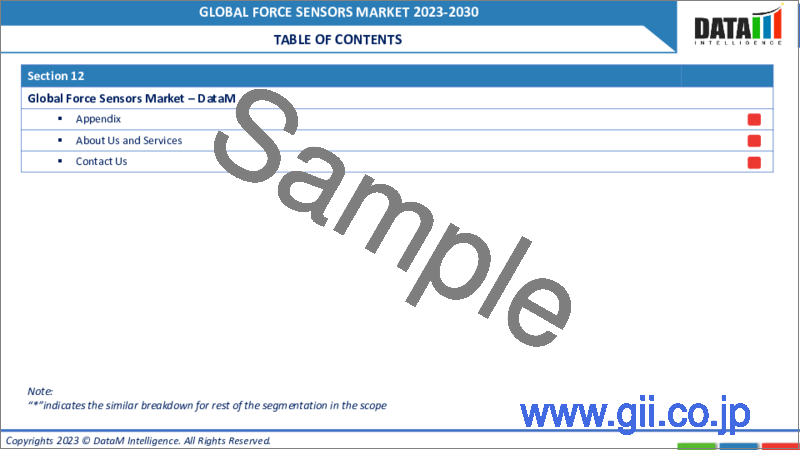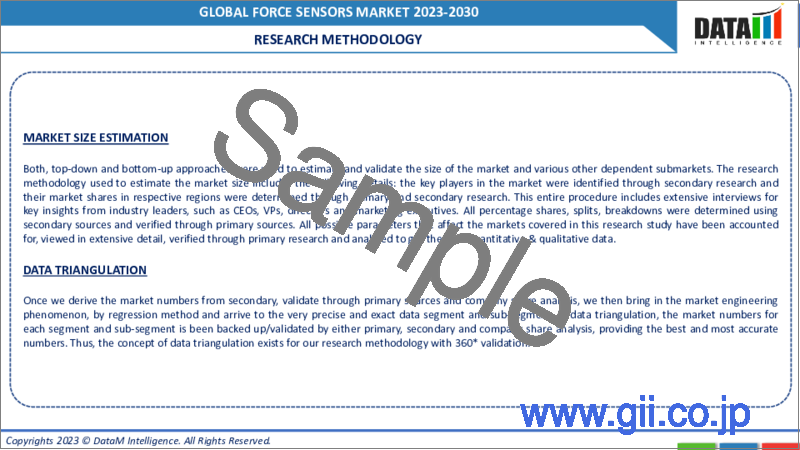|
|
市場調査レポート
商品コード
1208699
フォースセンサーの世界市場-2022-2029Global Force Sensors Market - 2022-2029 |
||||||
|
● お客様のご希望に応じて、既存データの加工や未掲載情報(例:国別セグメント)の追加などの対応が可能です。 詳細はお問い合わせください。 |
|||||||
| フォースセンサーの世界市場-2022-2029 |
|
出版日: 2023年02月01日
発行: DataM Intelligence
ページ情報: 英文 208 Pages
納期: 約2営業日
|
- 全表示
- 概要
- 目次
市場の概要
フォースセンサーの世界市場は、予測期間2022-2029年のCAGRは6.96%と予測されています。
フォースセンサーは、加えられた力の大きさを測定する装置です。力センサは、圧力、質量、重量、トルクなど、他の多くの測定に適応することができます。また、適切な温度補償を行えば、広い温度範囲で動作させることができます。力センサは、タッチスクリーン携帯電話や自動車産業など、多くのアプリケーションに利用されています。ロボット産業では、バリ取り、研削、穴あけなどの作業で力センサの大幅な採用が見られます。
市場力学
産業オートメーションの台頭は、フォースセンサーの世界市場の主要な促進要因です
近年、オートメーションとロボティクスは、産業分野を活性化し、変革する主要な要因となっています。インダストリー4.0は、様々な産業分野での自動化とロボティクスソリューションの採用を促進し、強化しています。力・トルクセンシングは、研削、バリ取り、サンディング、研磨などのロボット加工を可能にします。マシンテンディングの力覚センサは、CNCマシンのバイスにパーツを取り付ける際に、ロボットが治具の位置を確認するのに役立ちます。また、製品検査や梱包、ロボットによる組み立て用途にも力覚センサが役立っています。産業用オートメーションの台頭は、予測期間中の世界市場の主要な促進要因となっています。
フォースセンサーの小型化が困難であることが、世界市場を抑制すると予想されます
多くのエンドユーザー産業、特に医療産業では、力センサはより小さく、より薄くなることが予想されます。電子機器や装置の携帯化が進むにつれ、センサーも小型化する必要があります。しかし、センサーの小型化には大きな課題があり、多くのエンドユーザー産業での採用が制限される可能性があります。フォースセンサーの小型化の難しさは、予測期間中の世界市場の成長を阻む重要な要因となるでしょう。
自動車生産台数の増加は、力センサの世界市場に新たな機会をもたらすと予想されます
力センサは、自動車産業において幅広く使用されています。内燃機関のモニタリングやタイヤ圧の検知など、政府の排ガス規制が厳しくなっているため、フォースセンサーの利用が増加しています。また、自動車分野では、促進要因の安全性を向上させるために、旋回時の求心力を監視するためにフォースセンサーが使用されています。自動車生産の世界の成長は、予測期間中に力センサの世界市場に新たな機会を生み出すでしょう。
新しいフォースセンサーの開発のための長いリードタイムは、世界市場に課題を提示することが予想されます
新しいタイプのフォースセンサーの開発は、複数のパラメータを扱う複雑なプロセスです。新しいフォースセンサーの調査、設計、開発、プロトタイピング、フィールドテストには長いリードタイムが必要であり、世界のフォースセンサー市場の成長にとって大きな課題となっています。
COVID-19の影響分析
COVID-19の大流行は、世界の力センサ市場に大きな影響を与えました。パンデミックは、新しいセンサーのフィールドテストを含む研究開発活動を妨げました。製造装置、自動車、航空機、家庭用電化製品はロックダウンにより数週間停止し、消費者心理の低迷もロックダウン後の売上を阻害しました。ほとんどのセンサーで売上が減少しました。さらに、COVID-19の大流行によるサプライチェーンの制約により、多くの主要部品が不足し、フォースセンサーの製造に支障をきたしています。現在進行中の様々な課題にもかかわらず、パンデミックは力センサの世界市場の長期的な成長に影響を与えないと予想されます。
業界における最近の動向:
2022年3月、Apple Inc.は、次世代Apple Watchで3Dタッチを可能にする新しいフォースセンサーシステムの特許を取得しました。
2022年7月、Forsentek Co., Limitedは、産業オートメーション用途に特化した力およびトルクセンサの刷新された製品群を発売しました。
目次
第1章 フォースセンサーの世界市場の調査手法と範囲
- 調査手法
- 調査目的・調査範囲
第2章 フォースセンサーの世界市場-市場の定義と概要
第3章 フォースセンサーの世界市場-エグゼクティブサマリー
- 技術別の市場内訳
- アプリケーション別市場内訳
- 地域別市場内訳
第4章 フォースセンサーの世界市場-市場力学
- 市場影響要因
- 促進要因
- 産業用オートメーションの台頭
- 抑制要因
- フォースセンサーの小型化難易度
- ビジネスチャンス
- 世界の自動車生産の増加
- 影響分析
- 促進要因
第5章 フォースセンサーの世界市場- 産業分析
- ポーターのファイブフォース分析
- サプライチェーン分析
- 価格設定分析
- 規制分析
第6章 フォースセンサーの世界市場-COVID-19分析
- COVID-19の市場分析
- COVID-19登場前の市場シナリオ
- COVID-19の現在の市場シナリオ
- COVID-19以降、または将来のシナリオ
- COVID-19の中での価格ダイナミクス
- 需要-供給スペクトラム
- パンデミック時の市場に関連する政府の取り組み
- メーカーの戦略的な取り組み
- まとめ
第7章 フォースセンサーの世界市場- 技術別
- 圧電型フォースセンサー
- ストレインゲージ
- ピエゾ抵抗光学式
- 超音波式
- その他
第8章 フォースセンサーの世界市場~アプリケーション別
- 航空宇宙・防衛
- 医療・製薬
- 製薬・バイオ産業
- 農業分野
- 印刷・パッケージング
- 工業
- 自動車産業
- コンシューマーエレクトロニクス
- その他
第9章 フォースセンサーの世界市場- 地域別
- 北米
- 米国
- カナダ
- メキシコ
- 欧州
- ドイツ
- 英国
- フランス
- イタリア
- スペイン
- その他欧州
- 南米
- ブラジル
- アルゼンチン
- その他の南米地域
- アジア太平洋地域
- 中国
- インド
- 日本
- オーストラリア
- その他アジア太平洋地域
- 中東とアフリカ
第10章 フォースセンサーの世界市場- 競争情勢
- 競合シナリオ
- 市況分析/シェア分析
- M&A(合併・買収)分析
第11章 フォースセンサーの世界市場-企業プロファイル
- Tekscan
- 企業概要
- 製品ポートフォリオと説明
- 主なハイライト
- 財務概要
- TE Connectivity
- Sensitronics
- Texas Instruments
- ATI Industrial Automation
- KISTLER
- Futek Advanced Sensor Technology
- WACOH-TECH Inc.
- OnRobot A/S
- Omron Corporation
第12章 フォースセンサーの世界市場- 重要考察
第13章 フォースセンサーの世界市場-DataM
Market Overview
The global force sensors market was valued at US$ XX billion in 2021; it is projected to reach US$ XX billion by 2029, with growth at a CAGR of 6.96% over the forecast period 2022-2029.
A force sensor is a device that measures the amount of force applied. Force sensors are adaptable for many other measurements, such as pressure, mass, weight and torque. They can operate over a wide temperature range with proper temperature compensation. Force sensors have many applications, such as in touchscreen mobiles and the automotive industry. Significant adoption of force sensors is seen in the robotic industry for operations such as deburring, grinding and drilling.
Market Dynamics
The rise of industrial automation is a major driver for the global force sensor market:
In recent years, automation and robotics have been the primary factors reviving and transforming the industrial sector. Industry 4.0 is enhancing and driving the adoption of automation and robotics solutions to a large extent across various industrial verticals. Force and torque sensing enables robotic processes such as grinding, deburring, sanding and polishing. A force-torque sensor in machine tending can help a robot locate jig stops when putting a part in a vice on a CNC machine. Force sensing also helps in product inspection, packaging and robotic assembly applications. The rise of industrial automation is a major driver for the global market during the forecast period.
Difficulty in the miniaturization of force sensors is expected to restrain the global market:
For many end-user industries, especially the medical industry, force sensors are expected to be smaller and thinner. As electronic devices or equipment become increasingly portable, the sensors need to be smaller. However, miniaturizing the sensors presents significant challenges that can potentially limit their adoption in many end-user industries. The difficulty in miniaturizing force sensors will be a key factor in preventing the growth of the global market during the forecast period.
The rise in global automotive production is expected to generate new opportunities for the global force sensors market:
Force sensors are used extensively within the automotive industry. The use of force sensors for monitoring internal combustion engines, sensing tire pressure and others is increasing due to the stringent government regulation for the emission. Additionally, force sensors are used in the automobile sector to monitor centripetal force during turns to improve drivers' safety. The growth of global automotive production will generate new opportunities for the global force sensors market during the forecast period.
Long lead times for developing new force sensors are expected to present challenges for the global market:
Developing new types of force sensors is a complicated process involving working on multiple parameters. The research, design, development, prototyping and field testing of new force sensors requires long lead times and present major challenges for the growth of the global force sensors market.
COVID-19 Impact Analysis
The COVID-19 pandemic majorly impacted the global force sensors market. The pandemic hampered research and development activities, including the field testing of new sensors. Manufacturing equipment, automobiles, aircraft and consumer electronics were halted for weeks due to lockdowns and weak consumer sentiment also hindered sales in the post-lockdown period. Most of the sensors witnessed a decline in sales. Furthermore, supply chain constraints caused by the COVID-19 pandemic have hampered the manufacturing of force sensors due to a shortage of many key components. Despite the various ongoing challenges, the pandemic is not expected to impact the long-term growth of the global force sensors market.
Recent Developments in the Industry:
In March 2022, Apple Inc. patented a new force sensor system enabling 3D touch on the next generation of Apple watches.
In July 2022, Forsentek Co., Limited launched a revamped range of force and torque sensors specifically for industrial automation applications.
Market Segmentation:
The scope of the report covers segmentation based on technology, application and region. The global force sensors market is segmented by technology into piezoelectric force sensors, strain gauges, piezoresistive sensors, optical, ultrasonic and others. The global force sensors market is segmented by application into aerospace and defense, medical and pharmaceutical, agriculture, printing and packaging, industrial, automotive, consumer electronics and others. The global force sensors market is segmented by region into North America, South America, Europe, Asia-Pacific, Middle East and Africa.
Piezoelectric Force Sensor: The piezoelectric force sensor, also known as a load washer or measurement washer, is the classic piezoelectric measurement element for measuring a force along a single axis. Piezoelectric force sensors are designed for generating analog voltage signals as these are low-impedance voltage sensors.
Strain Gauge: Strain gauge-based force transducers always comprise a spring element to which force is applied. The force results in minimal deformation of the spring element. Strain gauges installed at appropriate points are extended and therefore show a change in resistance. The force sensor based on strain gauge technology uses strain gauges to measure the applied static and quasistatic tensile and compression forces.
Piezoresistive Sensor: A force-sensing resistor is a material whose resistance changes when a force, pressure or mechanical stress is applied. Piezoresistive/force sensing resistors have the advantages that they can be fabricated using flexible materials, but also they are very robust against noise and the conditioning electronics is simple; that is, in many cases, only a bias resistor is used.
Optical: Optical force sensor measures extremely slight forces exerted by small objects. Optical force sensors are used in many applications, such as gesture recognition, occupancy sensing, smart heating, etc.
Ultrasonic: Ultrasonic force sensors emit high-frequency sound waves from an ultrasonic transducer and sense any changes to received pulses due to external forces to determine their presence.
Other: With capacitive force sensor technology, engineers can measure applied force at discreet points, even at very low levels, opening up a range of possibilities in next-gen consumer electronics, medical devices, robotics and many other applications.
Regional Classification:
According to the DataM Intelligence market research report, the global Force sensors market is divided into North America, South America, Europe, Asia-Pacific, Middle East and Africa.
North America holds a strong demand for force sensors due to well-developed automotive, oil and gas, consumer electronics and military and defense industries. U.S. is among the leading automotive and electronics manufacturers and holds a significant share globally. The growing demand for force sensors from these industries is the primary factor driving the growth of the North American force sensors market during the forecast period.
Europe is one of the leading consumers of electronics, automotive, oil and gas, food and beverage and holds a strong position in each industry. Europe is responsible for generating over 20% of the demand for industrial goods globally and holds a significant position in the automotive industry. Germany has a leading manufacturing industry in Europe. Despite the shift of manufacturing to Asia-Pacific, Europe still retains significant capacity and will be a major factor in driving the growth of the European force sensors market.
Automotive and transportation is the major end-user for force sensors in the Asia-Pacific, with large automotive production in China, India and Japan. Asia-Pacific holds the largest market share for force sensors due to the high demand in countries like India and China because of the rise in the electronics and automotive industries. Moreover, the high demand for electronics like mobile and tablets is also driving the market for the region. Due to growing demand from many key industries, the Asia-Pacific force sensors market will likely witness sustained growth in the coming years.
Competitive Analysis:
The global force sensors market is fragmented, with major international players having the largest market share. The competitive environment in this market is expected to intensify further with an increase in product extensions, technological innovations and M&A. International players are expected to grow inorganically by acquiring regional or local players.
Major Companies:
Some key companies contributing to the global force sensors market growth include Tekscan, TE Connectivity, Sensitronics, Texas Instruments, ATI Industrial Automation, KISTLER, Futek Advanced Sensor Technology, WACOH-TECH Inc., OnRobot A/S, Omron Corporation and Leptrino Inc, among others.
The Full Report has the below insights.
The report offers a comprehensive evaluation of the market in terms of Market Value (US$) and Y-o-Y Growth Rates (%). It does so via in-depth qualitative insights, historical data (2020-2021) and verifiable projections about market size during the forecast period (2022-2029).
Visualize the composition of the global Force sensors market segmentation by drone type, application and region, highlighting the key commercial assets and players.
By Technology: Piezoelectric Force Sensors, Strain Gauge, Piezoresistive Optical, Ultrasonic and Others
By Application: Aerospace and Defense, Medical and Pharmaceutical, Agriculture, Printing and Packaging, Industrial, Automotive, Consumer Electronics and Others
By Region: North America, South America, Europe, Asia-Pacific, Middle East and Africa
Identify commercial opportunities in the global Force sensors market by analyzing trends and co-development deals.
The report also covers data insights on various industry forces such as porter's five forces, regulations in each country, reimbursement scenario, technological advancements, PEST analysis and pricing analysis.
Excel data sheet with thousands of global Force sensors market-level 4/5 segmentation data points.
PDF report with the most relevant analysis cogently put together after exhaustive qualitative interviews and in-depth market study.
Product mapping in excel for the key product of all major market players
The global force sensors market report would provide access to an approx. 53 market data table, 50 figures and 208 pages.
Table of Contents
1. Global Force Sensors Market Methodology and Scope
- 1.1. Research Methodology
- 1.2. Research Objective and Scope of the Report
2. Global Force Sensors Market - Market Definition and Overview
3. Global Force Sensors Market - Executive Summary
- 3.1. Market Snippet By Technology
- 3.2. Market Snippet By Application
- 3.3. Market Snippet By Region
4. Global Force Sensors Market-Market Dynamics
- 4.1. Market Impacting Factors
- 4.1.1. Drivers
- 4.1.1.1. The rise of industrial automation
- 4.1.1.2. XX
- 4.1.2. Restraints
- 4.1.2.1. Difficulty in miniaturization of force sensors
- 4.1.2.2. XX
- 4.1.3. Opportunity
- 4.1.3.1. The rise in global automotive production
- 4.1.4. Impact Analysis
- 4.1.1. Drivers
5. Global Force Sensors Market - Industry Analysis
- 5.1. Porter's Five Forces Analysis
- 5.2. Supply Chain Analysis
- 5.3. Pricing Analysis
- 5.4. Regulatory Analysis
6. Global Force Sensors Market - COVID-19 Analysis
- 6.1. Analysis of COVID-19 on the Market
- 6.1.1. Before COVID-19 Market Scenario
- 6.1.2. Present COVID-19 Market Scenario
- 6.1.3. After COVID-19 or Future Scenario
- 6.2. Pricing Dynamics Amid COVID-19
- 6.3. Demand-Supply Spectrum
- 6.4. Government Initiatives Related to the Market During Pandemic
- 6.5. Manufacturers Strategic Initiatives
- 6.6. Conclusion
7. Global Force Sensors Market - By Technology
- 7.1. Introduction
- 7.1.1. Market Size Analysis and Y-o-Y Growth Analysis (%), By Technology
- 7.1.2. Market Attractiveness Index, By Technology
- 7.2. Piezoelectric Force Sensors*
- 7.2.1. Introduction
- 7.2.2. Market Size Analysis and Y-o-Y Growth Analysis (%)
- 7.3. Strain Gauge
- 7.4. Piezoresistive Optical
- 7.5. Ultrasonic
- 7.6. Others
8. Global Force Sensors Market - By Application
- 8.1. Introduction
- 8.1.1. Market Size Analysis and Y-o-Y Growth Analysis (%), By Application
- 8.1.2. Market Attractiveness Index, By Application
- 8.2. Aerospace and Defense*
- 8.2.1. Introduction
- 8.2.2. Market Size Analysis and Y-o-Y Growth Analysis (%)
- 8.3. Medical and Pharmaceutical
- 8.4. Pharmaceutical and Biotechnology Industry
- 8.5. Agriculture
- 8.6. Printing and Packaging
- 8.7. Industrial
- 8.8. Automotive
- 8.9. Consumer Electronics
- 8.10. Others
9. Global Force Sensors Market - By Region
- 9.1. Introduction
- 9.2. Market Size Analysis and Y-o-Y Growth Analysis (%), By Region
- 9.3. Market Attractiveness Index, By Region
- 9.4. North America
- 9.4.1. Introduction
- 9.4.2. Key Region-Specific Dynamics
- 9.4.3. Market Size Analysis and Y-o-Y Growth Analysis (%), By Technology
- 9.4.4. Market Size Analysis and Y-o-Y Growth Analysis (%), By Application
- 9.4.5. Market Size Analysis and Y-o-Y Growth Analysis (%), By Country
- 9.4.5.1. U.S.
- 9.4.5.2. Canada
- 9.4.5.3. Mexico
- 9.5. Europe
- 9.5.1. Introduction
- 9.5.2. Key Region-Specific Dynamics
- 9.5.3. Market Size Analysis and Y-o-Y Growth Analysis (%), By Technology
- 9.5.4. Market Size Analysis and Y-o-Y Growth Analysis (%), By Application
- 9.5.5. Market Size Analysis and Y-o-Y Growth Analysis (%), By Country
- 9.5.5.1. Germany
- 9.5.5.2. UK
- 9.5.5.3. France
- 9.5.5.4. Italy
- 9.5.5.5. Spain
- 9.5.5.6. Rest of Europe
- 9.6. South America
- 9.6.1. Introduction
- 9.6.2. Key Region-Specific Dynamics
- 9.6.3. Market Size Analysis and Y-o-Y Growth Analysis (%), By Technology
- 9.6.4. Market Size Analysis and Y-o-Y Growth Analysis (%), By Application
- 9.6.5. Market Size Analysis and Y-o-Y Growth Analysis (%), By Country
- 9.6.5.1. Brazil
- 9.6.5.2. Argentina
- 9.6.5.3. Rest of South America
- 9.7. Asia-Pacific
- 9.7.1. Introduction
- 9.7.2. Key Region-Specific Dynamics
- 9.7.3. Market Size Analysis and Y-o-Y Growth Analysis (%), By Technology
- 9.7.4. Market Size Analysis and Y-o-Y Growth Analysis (%), By Application
- 9.7.5. Market Size Analysis and Y-o-Y Growth Analysis (%), By Country
- 9.7.5.1. China
- 9.7.5.2. India
- 9.7.5.3. Japan
- 9.7.5.4. Australia
- 9.7.5.5. Rest of Asia-Pacific
- 9.8. Middle East and Africa
- 9.8.1. Introduction
- 9.8.2. Key Region-Specific Dynamics
- 9.8.3. Market Size Analysis and Y-o-Y Growth Analysis (%), By Technology
- 9.8.4. Market Size Analysis and Y-o-Y Growth Analysis (%), By Application
10. Global Force Sensors Market - Competitive Landscape
- 10.1. Competitive Scenario
- 10.2. Market Positioning/Share Analysis
- 10.3. Mergers and Acquisitions Analysis
11. Global Force Sensors Market - Company Profiles
- 11.1. Tekscan
- 11.1.1. Company Overview
- 11.1.2. Product Portfolio and Description
- 11.1.3. Key Highlights
- 11.1.4. Financial Overview
- 11.2. TE Connectivity
- 11.3. Sensitronics
- 11.4. Texas Instruments
- 11.5. ATI Industrial Automation
- 11.6. KISTLER
- 11.7. Futek Advanced Sensor Technology
- 11.8. WACOH-TECH Inc.
- 11.9. OnRobot A/S
- 11.10. Omron Corporation
LIST NOT EXHAUSTIVE
12. Global Force Sensors Market - Premium Insights
13. Global Force Sensors Market - DataM
- 13.1. Appendix
- 13.2. About Us and Services
- 13.3. Contact Us




